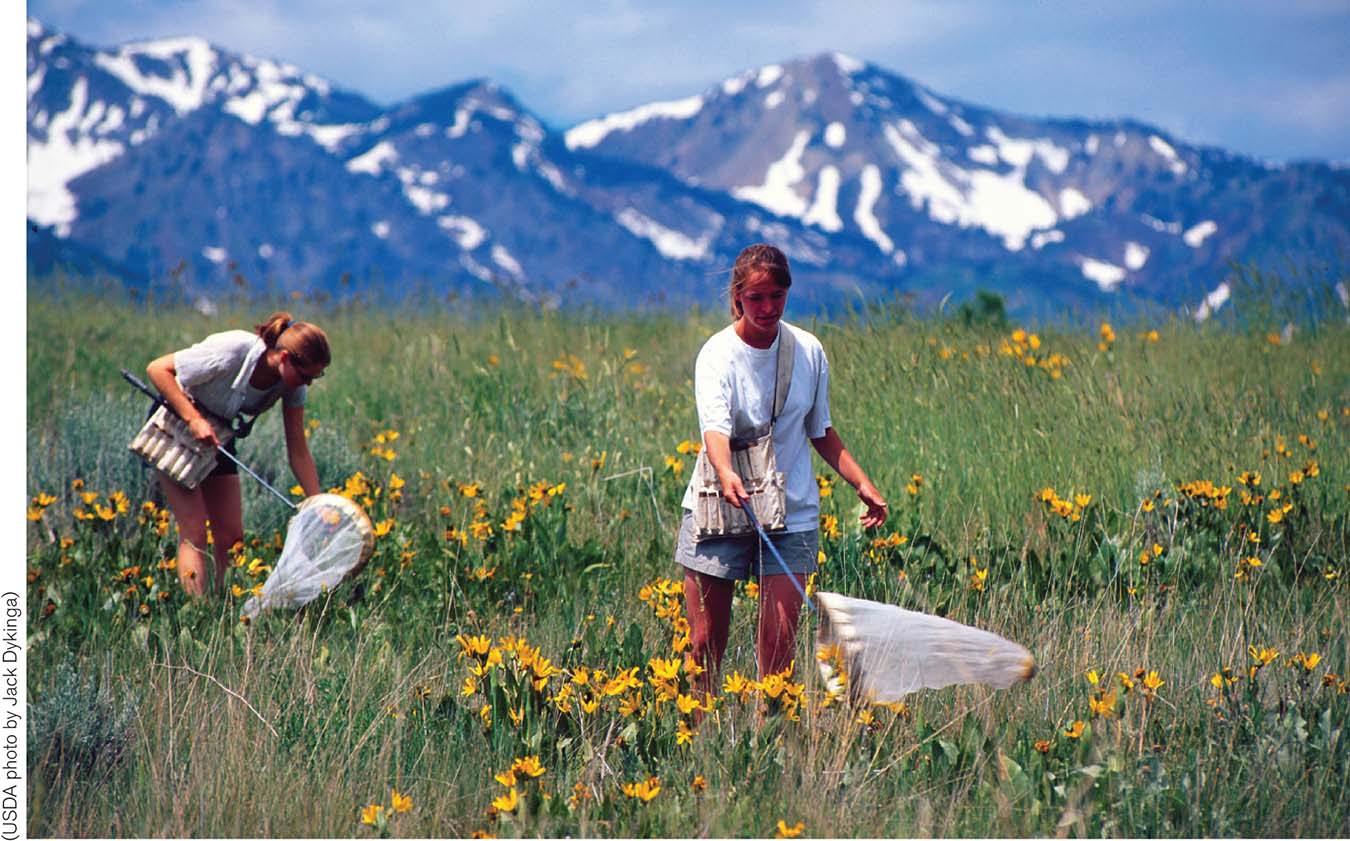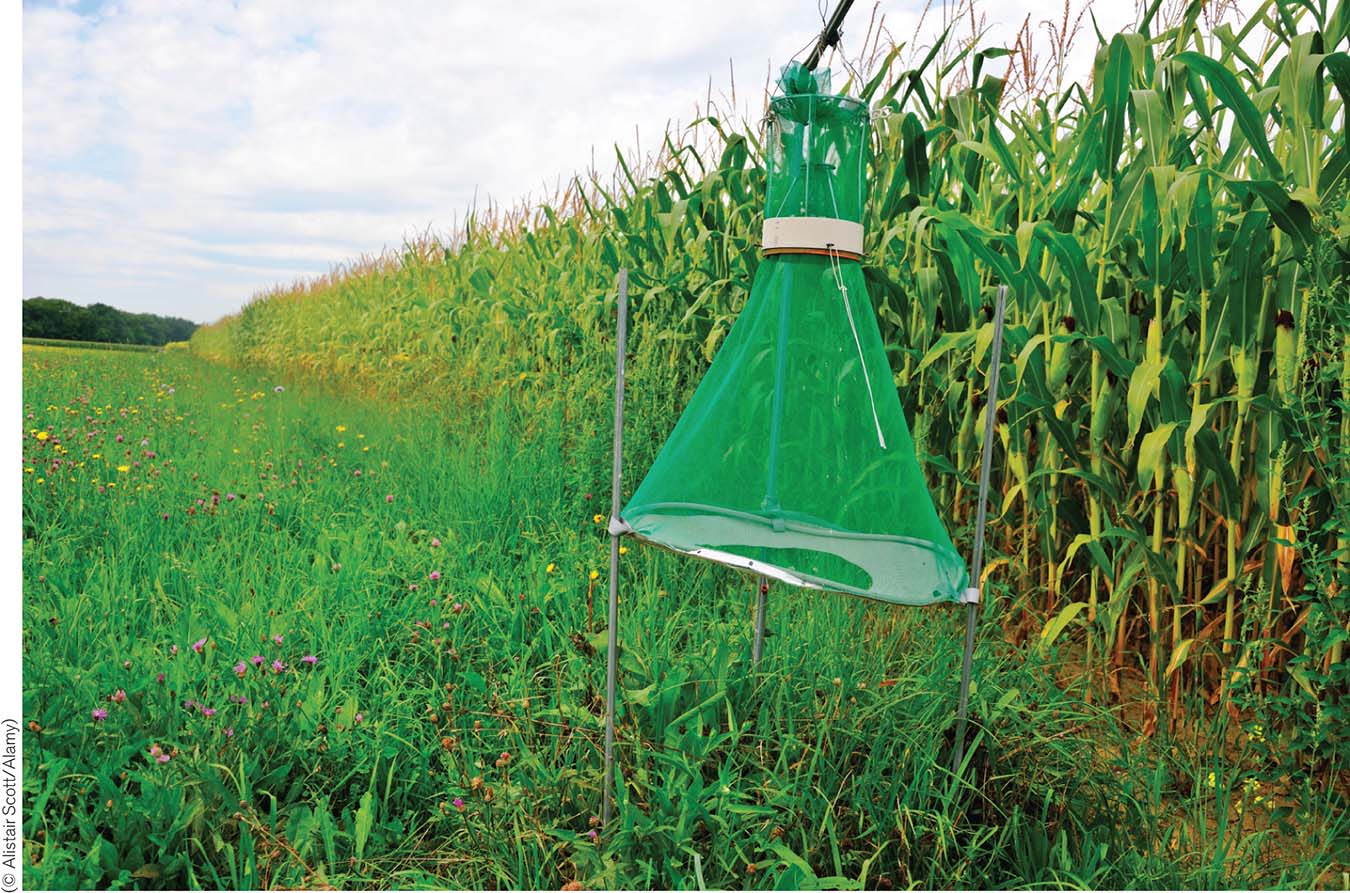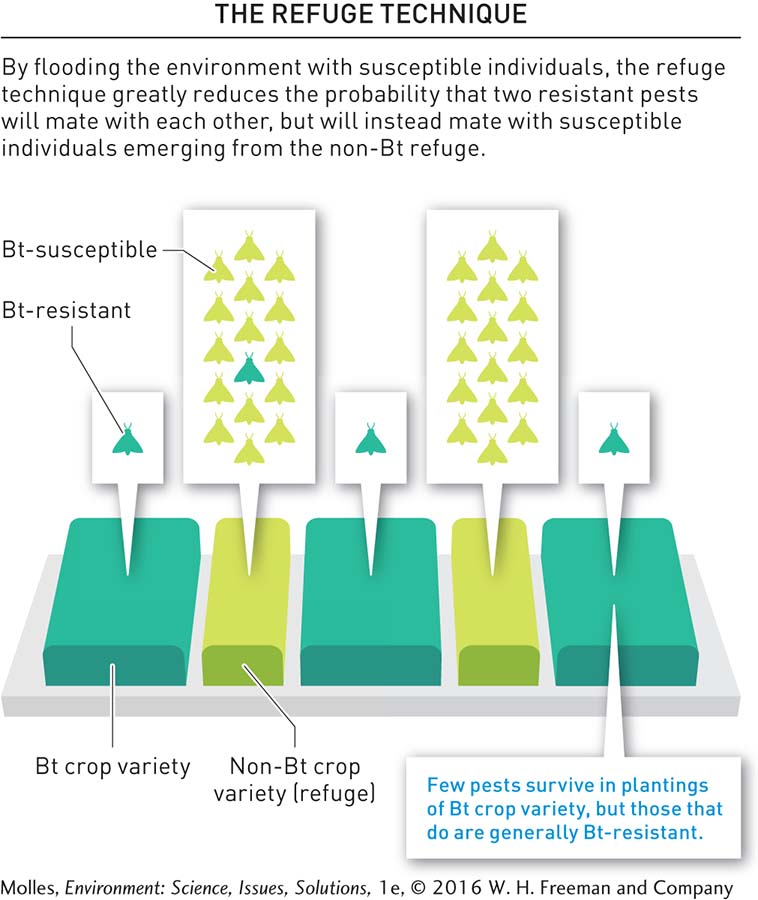Integrated Pest Management
Integrated Pest Management (IPM)
An approach to managing pests (e.g., insects, pathogens, weeds) that incorporates multiple sources of information to contain pest damage within acceptable limits while trying to minimize harm to people, property, and the environment.
Pesticide resistance, as we saw in the case of the Colorado potato beetle, has been one consequence of intensive agriculture, which has been sustained by the application of larger quantities and varieties of pesticides. To avoid getting caught in an endless cycle, agriculturalists developed Integrated Pest Management, or IPM, which incorporates multiple sources of information to contain pest damage within acceptable limits, while trying to minimize harm to people, property, and the environment. Practitioners begin by investing in preventative measures, such as planting pest-resistant crop varieties, rotating crops to prevent the buildup of pests, and removing diseased or infested plants. During the growing season, they monitor for early signs of both pest populations and natural enemies of the pests, which could keep those pests in check (Figure 7.44). Finally, they begin killing pest insects using highly targeted techniques, such as trapping and mechanical controls, before resorting to broad-spectrum pesticides (Figure 7.45).
INFORMATION IS ESSENTIAL TO SUCCESSFUL INTEGRATED PEST MANAGEMENT

FIGURE 7.44 Monitoring pest populations to determine whether control measures are warranted is a key element of IPM.
(USDA photo by Jack Dykinga)
INTEGRATED PEST MANAGEMENT RECOMMENDS A GRADED RESPONSE TO PEST CONTROL

FIGURE 7.45 As pest populations begin to build, IPM begins with control methods that have the lowest environmental impact. For example, traps such as this one containing chemicals that attract specific pest species, can be effective at controlling some problem species and have little environmental impact.
(© Alistair Scott/Alamy)
GM crops such as Bt corn have not ended the need for IPM because pests can still evolve resistance to these insect-killing crops. The key to controlling Bt-resistant pests is to make sure that each generation of the crop pest includes susceptible individuals. To do so, farmers plant a certain proportion of their fields in non-Bt varieties of their crop. Almost all the insect pests living on these non-Bt crop refuges will be susceptible to Bt. The mates for the small number of resistant pests growing to maturity on the Bt variety of the crop will be almost entirely Bt-susceptible individuals (Figure 7.46). Consequently, the offspring of the resistant individuals mating with nonresistant individuals will be killed when they feed on Bt crop tissue, and the resistance traits will not increase in frequency in the pest population.
FARMERS USE “THE REFUGE TECHNIQUE” TO COMBAT Bt RESISTANCE IN CROP PESTS

FIGURE 7.46 The refuge technique for preventing evolution of Bt resistance depends on producing abundant Bt-susceptible mates for any resistant variants of the pest that emerge in each generation. The success of this approach depends on the offspring of matings between susceptible and resistant pests being poisoned by the Bt toxin.
Herbicide-resistant GM crops have been widely adopted by farmers, making up, for example, 91% of the soybeans grown in the United States. However, with the widespread use of herbicides, farmers are observing the evolution of herbicide-resistant “super weeds.” The key to avoiding herbicide resistance is for farmers to vary the form and strength of evolutionary selection on the weed population. Applying the same herbicide repeatedly to a weed population will exert strong directional selection on the population for resistance to that herbicide (see Figure 3.6, page 64). In such circumstances, if resistance traits exist in the weed population, they will likely increase in frequency.
Rather than applying the same herbicide repeatedly, farmers can combine herbicide control with old-fashioned mechanical weeding. Alternatively, a farmer can switch between two types of herbicides with different modes of action. To be successful, sustainable agriculture requires paying close attention to the crop environment and having a sophisticated understanding of multiple natural processes, including evolution by natural selection.
Think About It
How does Integrated Pest Management (IPM) address some of the most severe environmental impacts associated with pesticide use?
How do you weigh the concerns over the planting of GM crops against their benefits when used in a program of IPM?
Would the refuge method for preventing the evolution of Bt resistance in crop pests (see Figure 7.46) work if Bt-resistant pests preferred to mate with other Bt-resistant individuals?
7.10–7.13 Solutions: Summary
The most sustainable approach to combating malnutrition and undernourishment around the world may be to help local farmers produce adequate quantities of nutritious food. Biodiversity in agriculture increases agricultural production and reduces chemical and energy inputs.
To minimize loss of healthy, fertile soils, cultivating with the contours in sloping lands or constructing terraces can reduce soil erosion. Growing crops with little tillage (low-till) or without tillage (no-till) can further reduce soil losses by decreasing soil disturbance and leaving crop residues on the field. Selective logging, restoring vegetative cover, and removing logging roads after logging help reduce soil losses from managed forests. Managing fuel and fire can reduce the chance of intense, catastrophic forest fires that lead to rapid soil erosion. On rangelands, proper stocking rates and periodic rest of the land can prevent desertification. Native populations of the Amazon Basin sustained agricultural production in highly weathered tropical forest soils by adding nutrients and charcoal rather than practicing nomadic, slash-and-burn agriculture.
Sustainable irrigation requires careful management of water and salts. More precise irrigation is an effective way to conserve water and control salts.
The key elements of Integrated Pest Management (IPM) are information about the state of pest populations and populations of their natural enemies, preventative practices to discourage pest populations, and staged control measures, beginning with the least risky. IPM increasingly involves GM crops, especially those that have been engineered for herbicide and insect resistance.


